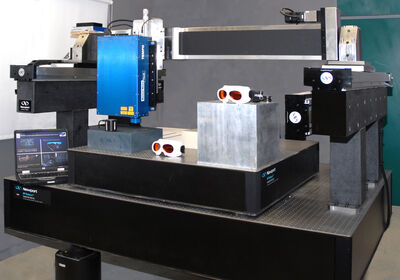Detailed view
Bench for Measurement at Ultrasonic Scale - MUSC
The MUSC test bench is a cutting-edge experimental tool for understanding the propagation of mechanical waves (seismic, ultrasonic) to develop new non-destructive techniques for monitoring subsoils, engineering structures and roadways.
The MUSC bench consists of:
- an optical table;
- a device that moves a laser interferometer (the receiver) along two axes over a surface area of 1 m2 (minimum increment 100 µm, accuracy 10 µm);
- a piezoelectric source along one axis (minimum increment 1 mm, accuracy 100 µm);
- control electronics (movement of the 3 axes, signal generation and acquisition).
The MUSC bench is unique in its measurement capabilities: micrometric precision positioning, measurement of nanometric displacements from 10kHz to 10MHz by laser interferometry, quantitative simulation of multi-source/multi-offset devices.
Practical information
Themes/sub-themes
- Infrastructure and materials
- Geotechnie
Industrial sector(s)
- Chemicals & Materials industries
- Construction industries
Laboratory
- GERS / GéoEND - Géophysique et évaluation non destructive
Field of expertise
- Ultrasonic measurement bench
- Small-scale experimentation
- Seismic methods
- Experimental modeling
Some photos
The platform in detail
Non-contact ultrasonic measurement can be used to address industrial applications such as high-efficiency amplitude measurement, as well as more fundamental issues such as wave propagation in highly heterogeneous media. In these cases, physical measurement is used to support theoretical approaches, to overcome the limitations of numerical modeling or the possible absence of 3D code. More generally, the advantages of non-contact ultrasonic measurements with a laser interferometer lie in its implementation and its technological specificities: thanks to the interplay of scaling relationships, high-frequency measurements enable the use of reduced-scale models (typically decimetric). These models can therefore be easily machined in large numbers, and edge effects can be pushed out of the study window. Research fields: seismic imaging, non-destructive evaluation using ultrasonic waves, seismic physical modeling at reduced scale for geophysics, at scale 1 for non-destructive evaluation.
Master internships, courses in Master civil engineering at Ecole Centrale de Nantes. 8 theses defended involving the M.U.S.C. bench. (Measurements at Ultrasonic SCales - Mesures Ultrasonores Sans Contact).
Training in physical modeling.
Research projects are carried out only with academic or industrial partners.


